fuel cap FORD EXPLORER 1998 2.G Owners Manual
[x] Cancel search | Manufacturer: FORD, Model Year: 1998, Model line: EXPLORER, Model: FORD EXPLORER 1998 2.GPages: 210, PDF Size: 1.65 MB
Page 7 of 210
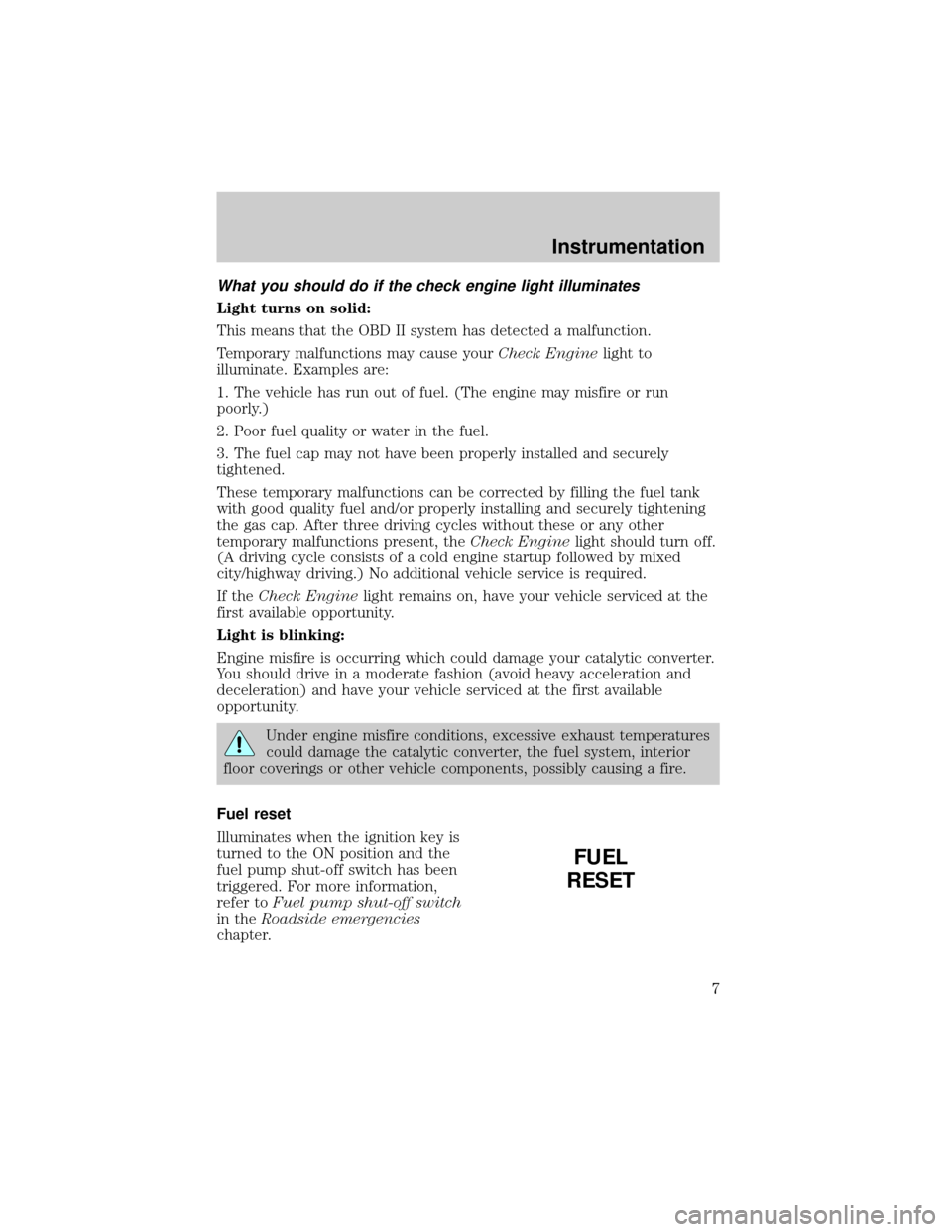
What you should do if the check engine light illuminates
Light turns on solid:
This means that the OBD II system has detected a malfunction.
Temporary malfunctions may cause yourCheck Enginelight to
illuminate. Examples are:
1. The vehicle has run out of fuel. (The engine may misfire or run
poorly.)
2. Poor fuel quality or water in the fuel.
3. The fuel cap may not have been properly installed and securely
tightened.
These temporary malfunctions can be corrected by filling the fuel tank
with good quality fuel and/or properly installing and securely tightening
the gas cap. After three driving cycles without these or any other
temporary malfunctions present, theCheck Enginelight should turn off.
(A driving cycle consists of a cold engine startup followed by mixed
city/highway driving.) No additional vehicle service is required.
If theCheck Enginelight remains on, have your vehicle serviced at the
first available opportunity.
Light is blinking:
Engine misfire is occurring which could damage your catalytic converter.
You should drive in a moderate fashion (avoid heavy acceleration and
deceleration) and have your vehicle serviced at the first available
opportunity.
Under engine misfire conditions, excessive exhaust temperatures
could damage the catalytic converter, the fuel system, interior
floor coverings or other vehicle components, possibly causing a fire.
Fuel reset
Illuminates when the ignition key is
turned to the ON position and the
fuel pump shut-off switch has been
triggered. For more information,
refer toFuel pump shut-off switch
in theRoadside emergencies
chapter.
FUEL
RESET
Instrumentation
7
Page 15 of 210
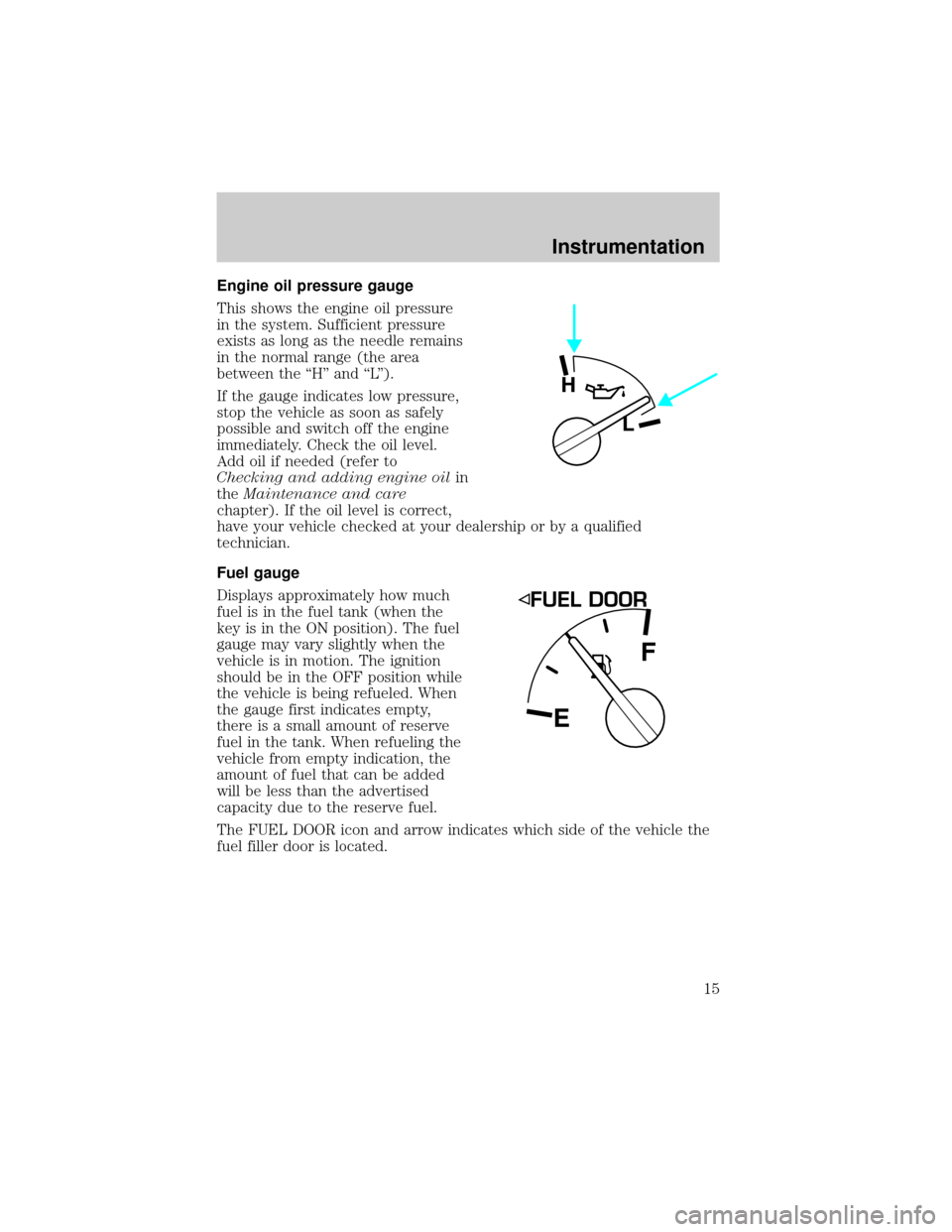
Engine oil pressure gauge
This shows the engine oil pressure
in the system. Sufficient pressure
exists as long as the needle remains
in the normal range (the area
between the ``H'' and ``L'').
If the gauge indicates low pressure,
stop the vehicle as soon as safely
possible and switch off the engine
immediately. Check the oil level.
Add oil if needed (refer to
Checking and adding engine oilin
theMaintenance and care
chapter). If the oil level is correct,
have your vehicle checked at your dealership or by a qualified
technician.
Fuel gauge
Displays approximately how much
fuel is in the fuel tank (when the
key is in the ON position). The fuel
gauge may vary slightly when the
vehicle is in motion. The ignition
should be in the OFF position while
the vehicle is being refueled. When
the gauge first indicates empty,
there is a small amount of reserve
fuel in the tank. When refueling the
vehicle from empty indication, the
amount of fuel that can be added
will be less than the advertised
capacity due to the reserve fuel.
The FUEL DOOR icon and arrow indicates which side of the vehicle the
fuel filler door is located.
H
L
EF
Instrumentation
15
Page 132 of 210
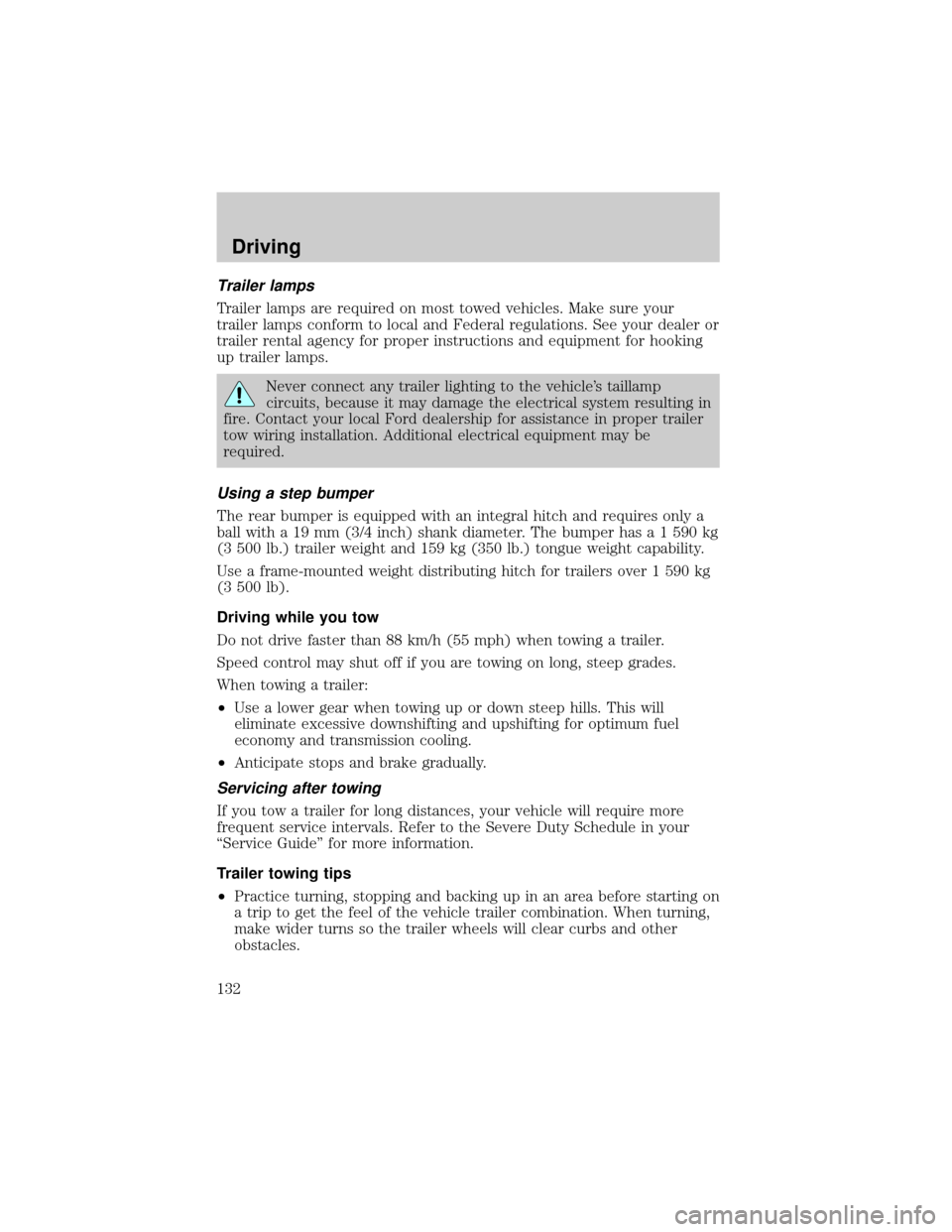
Trailer lamps
Trailer lamps are required on most towed vehicles. Make sure your
trailer lamps conform to local and Federal regulations. See your dealer or
trailer rental agency for proper instructions and equipment for hooking
up trailer lamps.
Never connect any trailer lighting to the vehicle's taillamp
circuits, because it may damage the electrical system resulting in
fire. Contact your local Ford dealership for assistance in proper trailer
tow wiring installation. Additional electrical equipment may be
required.
Using a step bumper
The rear bumper is equipped with an integral hitch and requires only a
ball with a 19 mm (3/4 inch) shank diameter. The bumper has a 1 590 kg
(3 500 lb.) trailer weight and 159 kg (350 lb.) tongue weight capability.
Use a frame-mounted weight distributing hitch for trailers over 1 590 kg
(3 500 lb).
Driving while you tow
Do not drive faster than 88 km/h (55 mph) when towing a trailer.
Speed control may shut off if you are towing on long, steep grades.
When towing a trailer:
²Use a lower gear when towing up or down steep hills. This will
eliminate excessive downshifting and upshifting for optimum fuel
economy and transmission cooling.
²Anticipate stops and brake gradually.
Servicing after towing
If you tow a trailer for long distances, your vehicle will require more
frequent service intervals. Refer to the Severe Duty Schedule in your
``Service Guide'' for more information.
Trailer towing tips
²Practice turning, stopping and backing up in an area before starting on
a trip to get the feel of the vehicle trailer combination. When turning,
make wider turns so the trailer wheels will clear curbs and other
obstacles.
Driving
132
Page 160 of 210
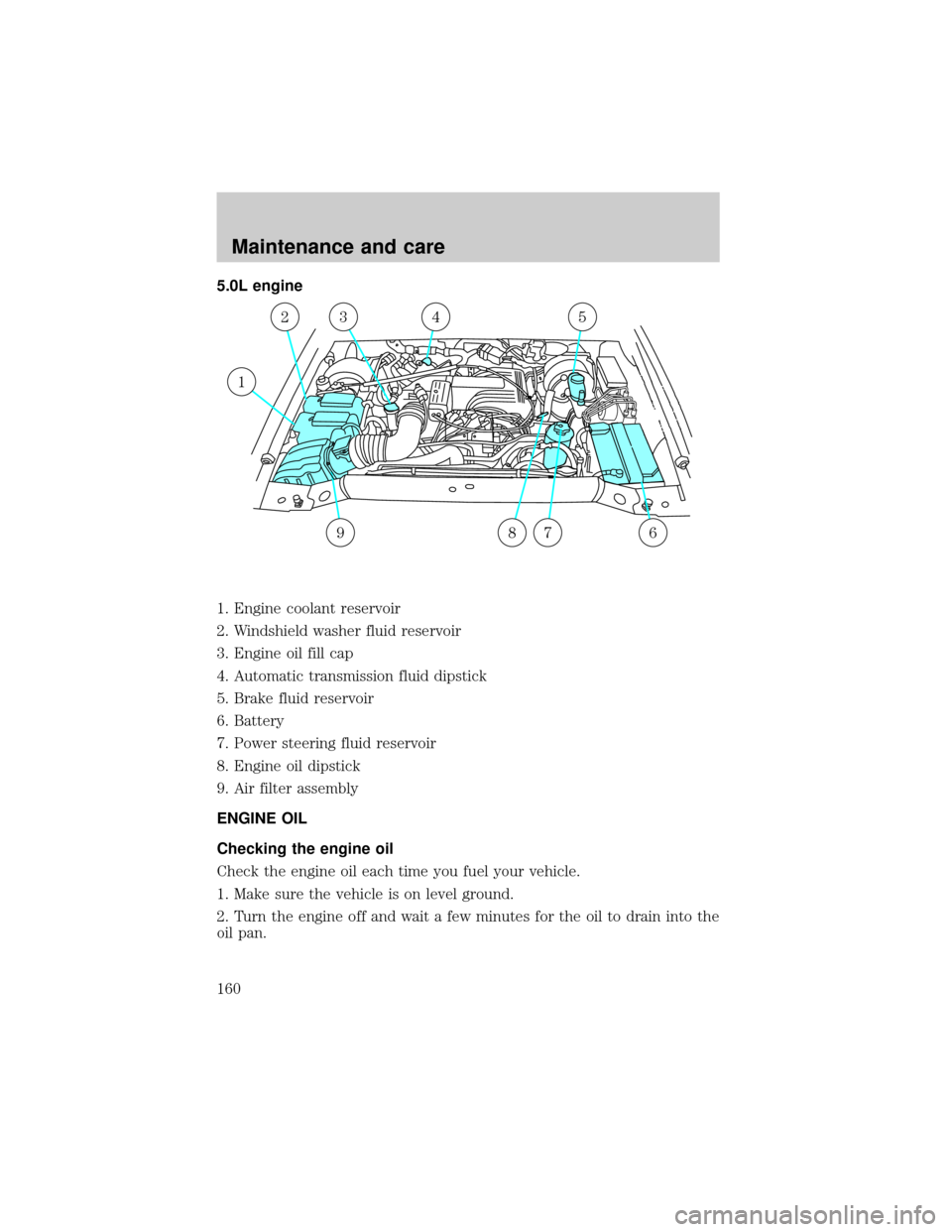
5.0L engine
1. Engine coolant reservoir
2. Windshield washer fluid reservoir
3. Engine oil fill cap
4. Automatic transmission fluid dipstick
5. Brake fluid reservoir
6. Battery
7. Power steering fluid reservoir
8. Engine oil dipstick
9. Air filter assembly
ENGINE OIL
Checking the engine oil
Check the engine oil each time you fuel your vehicle.
1. Make sure the vehicle is on level ground.
2. Turn the engine off and wait a few minutes for the oil to drain into the
oil pan.
1
23
6
54
879
Maintenance and care
160
Page 181 of 210
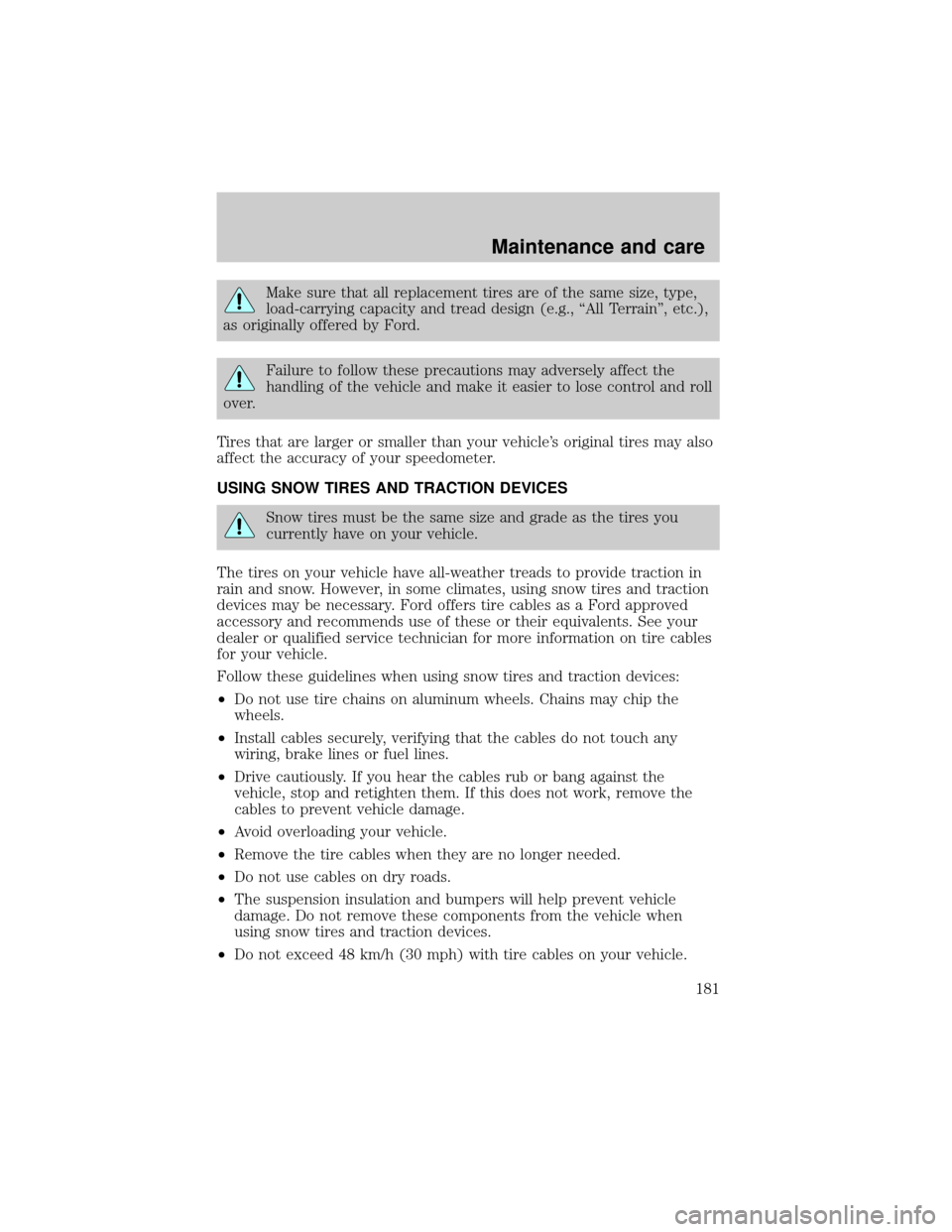
Make sure that all replacement tires are of the same size, type,
load-carrying capacity and tread design (e.g., ``All Terrain'', etc.),
as originally offered by Ford.
Failure to follow these precautions may adversely affect the
handling of the vehicle and make it easier to lose control and roll
over.
Tires that are larger or smaller than your vehicle's original tires may also
affect the accuracy of your speedometer.
USING SNOW TIRES AND TRACTION DEVICES
Snow tires must be the same size and grade as the tires you
currently have on your vehicle.
The tires on your vehicle have all-weather treads to provide traction in
rain and snow. However, in some climates, using snow tires and traction
devices may be necessary. Ford offers tire cables as a Ford approved
accessory and recommends use of these or their equivalents. See your
dealer or qualified service technician for more information on tire cables
for your vehicle.
Follow these guidelines when using snow tires and traction devices:
²Do not use tire chains on aluminum wheels. Chains may chip the
wheels.
²Install cables securely, verifying that the cables do not touch any
wiring, brake lines or fuel lines.
²Drive cautiously. If you hear the cables rub or bang against the
vehicle, stop and retighten them. If this does not work, remove the
cables to prevent vehicle damage.
²Avoid overloading your vehicle.
²Remove the tire cables when they are no longer needed.
²Do not use cables on dry roads.
²The suspension insulation and bumpers will help prevent vehicle
damage. Do not remove these components from the vehicle when
using snow tires and traction devices.
²Do not exceed 48 km/h (30 mph) with tire cables on your vehicle.
Maintenance and care
181
Page 182 of 210
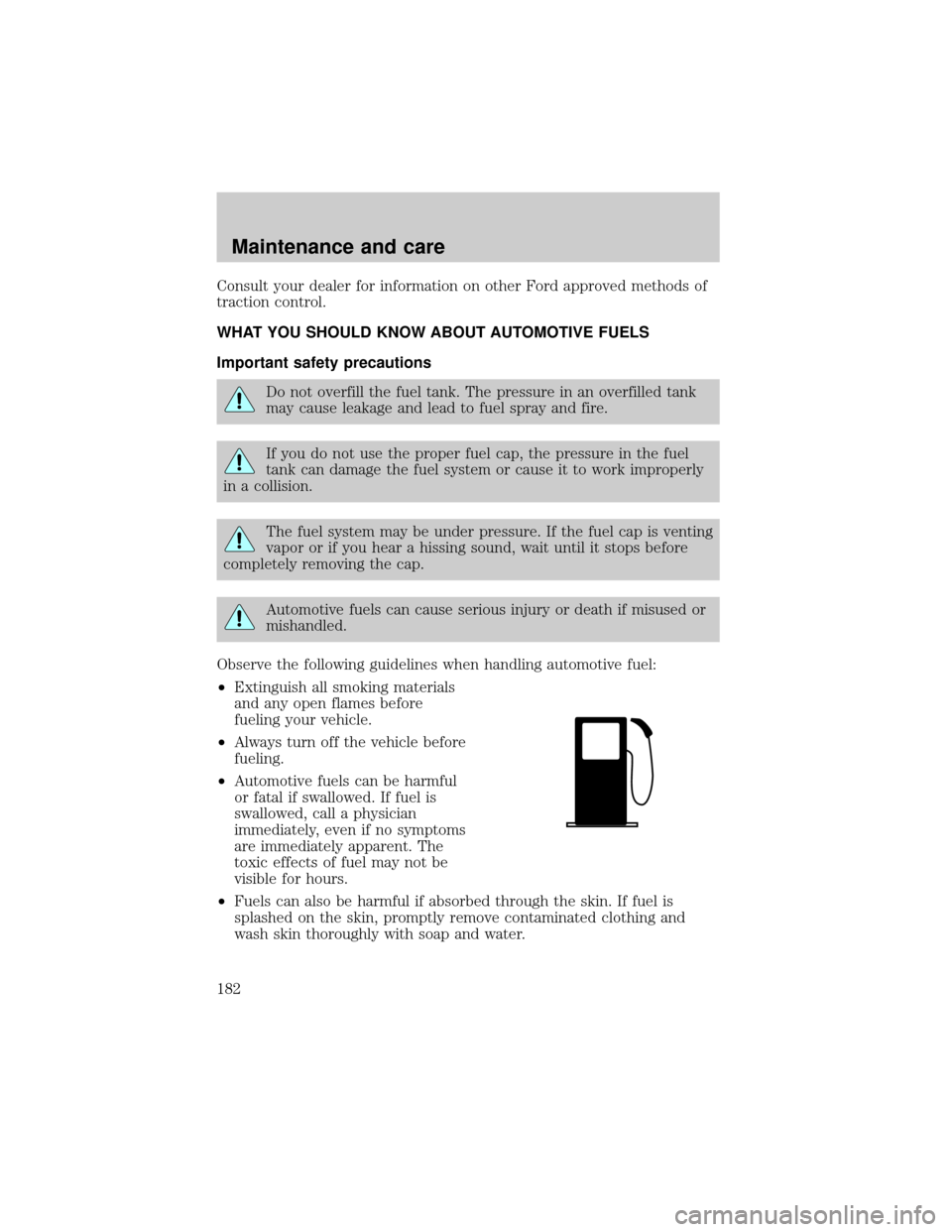
Consult your dealer for information on other Ford approved methods of
traction control.
WHAT YOU SHOULD KNOW ABOUT AUTOMOTIVE FUELS
Important safety precautions
Do not overfill the fuel tank. The pressure in an overfilled tank
may cause leakage and lead to fuel spray and fire.
If you do not use the proper fuel cap, the pressure in the fuel
tank can damage the fuel system or cause it to work improperly
in a collision.
The fuel system may be under pressure. If the fuel cap is venting
vapor or if you hear a hissing sound, wait until it stops before
completely removing the cap.
Automotive fuels can cause serious injury or death if misused or
mishandled.
Observe the following guidelines when handling automotive fuel:
²Extinguish all smoking materials
and any open flames before
fueling your vehicle.
²Always turn off the vehicle before
fueling.
²Automotive fuels can be harmful
or fatal if swallowed. If fuel is
swallowed, call a physician
immediately, even if no symptoms
are immediately apparent. The
toxic effects of fuel may not be
visible for hours.
²Fuels can also be harmful if absorbed through the skin. If fuel is
splashed on the skin, promptly remove contaminated clothing and
wash skin thoroughly with soap and water.
Maintenance and care
182
Page 197 of 210
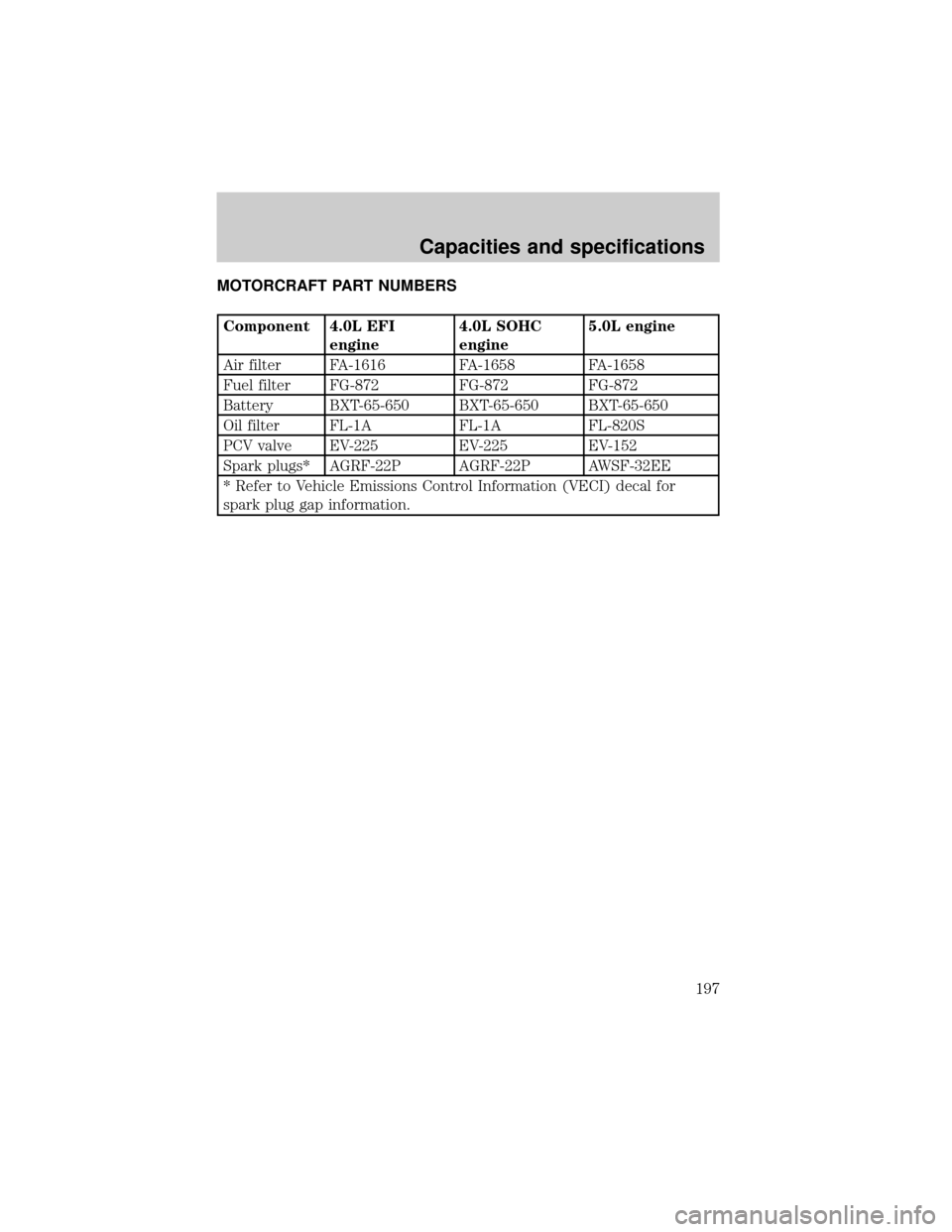
MOTORCRAFT PART NUMBERS
Component 4.0L EFI
engine4.0L SOHC
engine5.0L engine
Air filter FA-1616 FA-1658 FA-1658
Fuel filter FG-872 FG-872 FG-872
Battery BXT-65-650 BXT-65-650 BXT-65-650
Oil filter FL-1A FL-1A FL-820S
PCV valve EV-225 EV-225 EV-152
Spark plugs* AGRF-22P AGRF-22P AWSF-32EE
* Refer to Vehicle Emissions Control Information (VECI) decal for
spark plug gap information.
Capacities and specifications
197
Page 200 of 210
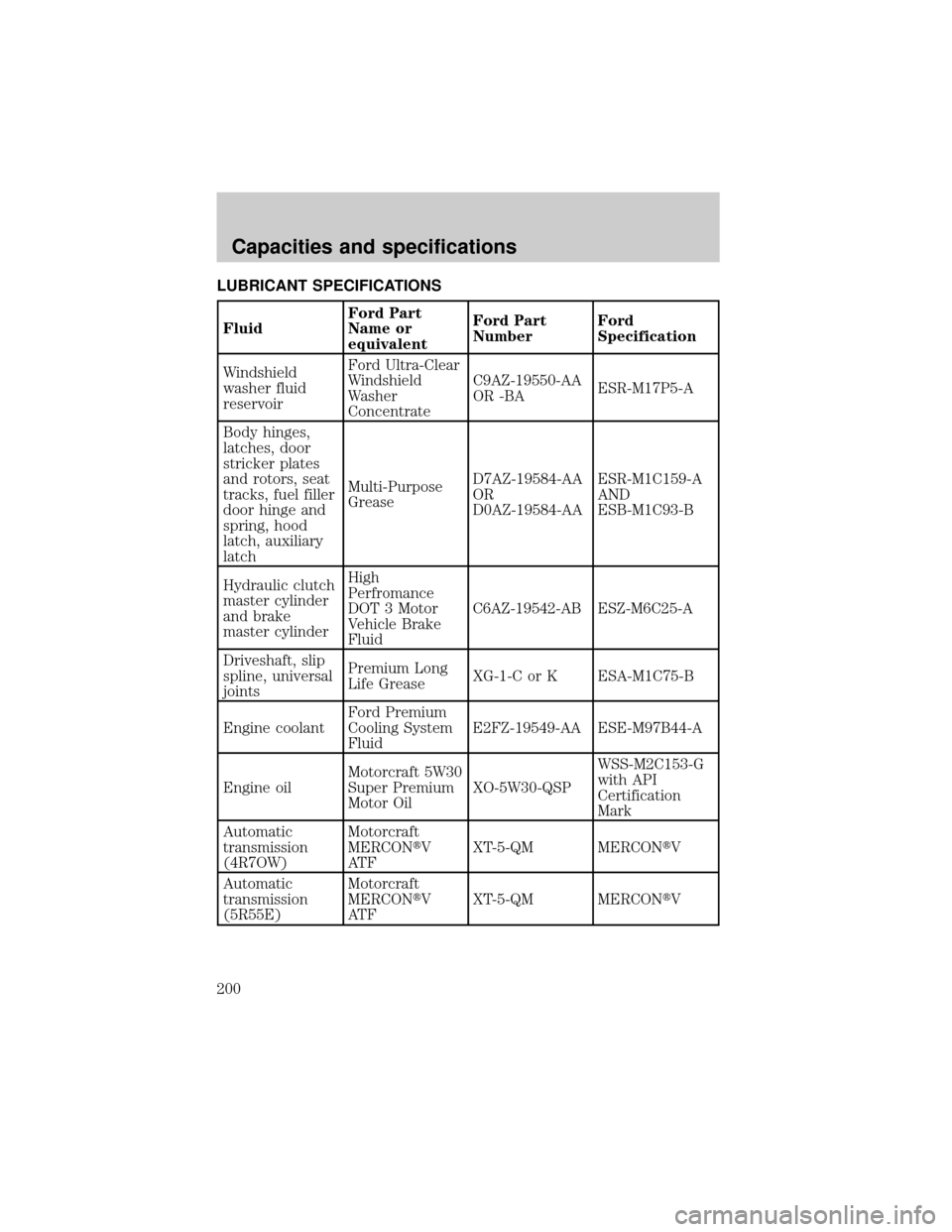
LUBRICANT SPECIFICATIONS
FluidFord Part
Name or
equivalentFord Part
NumberFord
Specification
Windshield
washer fluid
reservoirFord Ultra-Clear
Windshield
Washer
ConcentrateC9AZ-19550-AA
OR -BAESR-M17P5-A
Body hinges,
latches, door
stricker plates
and rotors, seat
tracks, fuel filler
door hinge and
spring, hood
latch, auxiliary
latchMulti-Purpose
GreaseD7AZ-19584-AA
OR
D0AZ-19584-AAESR-M1C159-A
AND
ESB-M1C93-B
Hydraulic clutch
master cylinder
and brake
master cylinderHigh
Perfromance
DOT 3 Motor
Vehicle Brake
FluidC6AZ-19542-AB ESZ-M6C25-A
Driveshaft, slip
spline, universal
jointsPremium Long
Life GreaseXG-1-C or K ESA-M1C75-B
Engine coolantFord Premium
Cooling System
FluidE2FZ-19549-AA ESE-M97B44-A
Engine oilMotorcraft 5W30
Super Premium
Motor OilXO-5W30-QSPWSS-M2C153-G
with API
Certification
Mark
Automatic
transmission
(4R7OW)Motorcraft
MERCONtV
AT FXT-5-QM MERCONtV
Automatic
transmission
(5R55E)Motorcraft
MERCONtV
AT FXT-5-QM MERCONtV
Capacities and specifications
200
Page 202 of 210
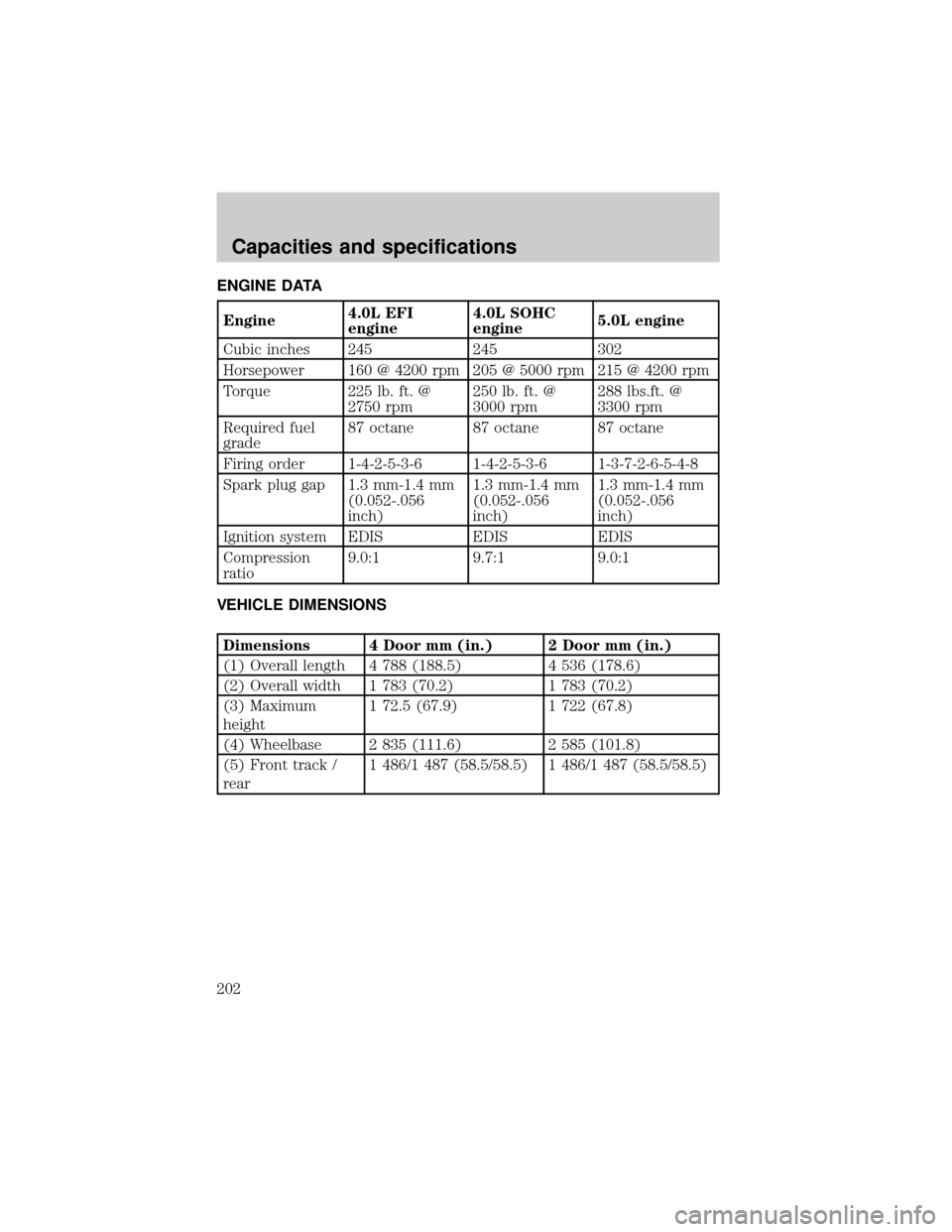
ENGINE DATA
Engine4.0L EFI
engine4.0L SOHC
engine5.0L engine
Cubic inches 245 245 302
Horsepower 160 @ 4200 rpm 205 @ 5000 rpm 215 @ 4200 rpm
Torque 225 lb. ft. @
2750 rpm250 lb. ft. @
3000 rpm288 lbs.ft. @
3300 rpm
Required fuel
grade87 octane 87 octane 87 octane
Firing order 1-4-2-5-3-6 1-4-2-5-3-6 1-3-7-2-6-5-4-8
Spark plug gap 1.3 mm-1.4 mm
(0.052-.056
inch)1.3 mm-1.4 mm
(0.052-.056
inch)1.3 mm-1.4 mm
(0.052-.056
inch)
Ignition system EDIS EDIS EDIS
Compression
ratio9.0:1 9.7:1 9.0:1
VEHICLE DIMENSIONS
Dimensions 4 Door mm (in.) 2 Door mm (in.)
(1) Overall length 4 788 (188.5) 4 536 (178.6)
(2) Overall width 1 783 (70.2) 1 783 (70.2)
(3) Maximum
height1 72.5 (67.9) 1 722 (67.8)
(4) Wheelbase 2 835 (111.6) 2 585 (101.8)
(5) Front track /
rear1 486/1 487 (58.5/58.5) 1 486/1 487 (58.5/58.5)
Capacities and specifications
202
Page 210 of 210
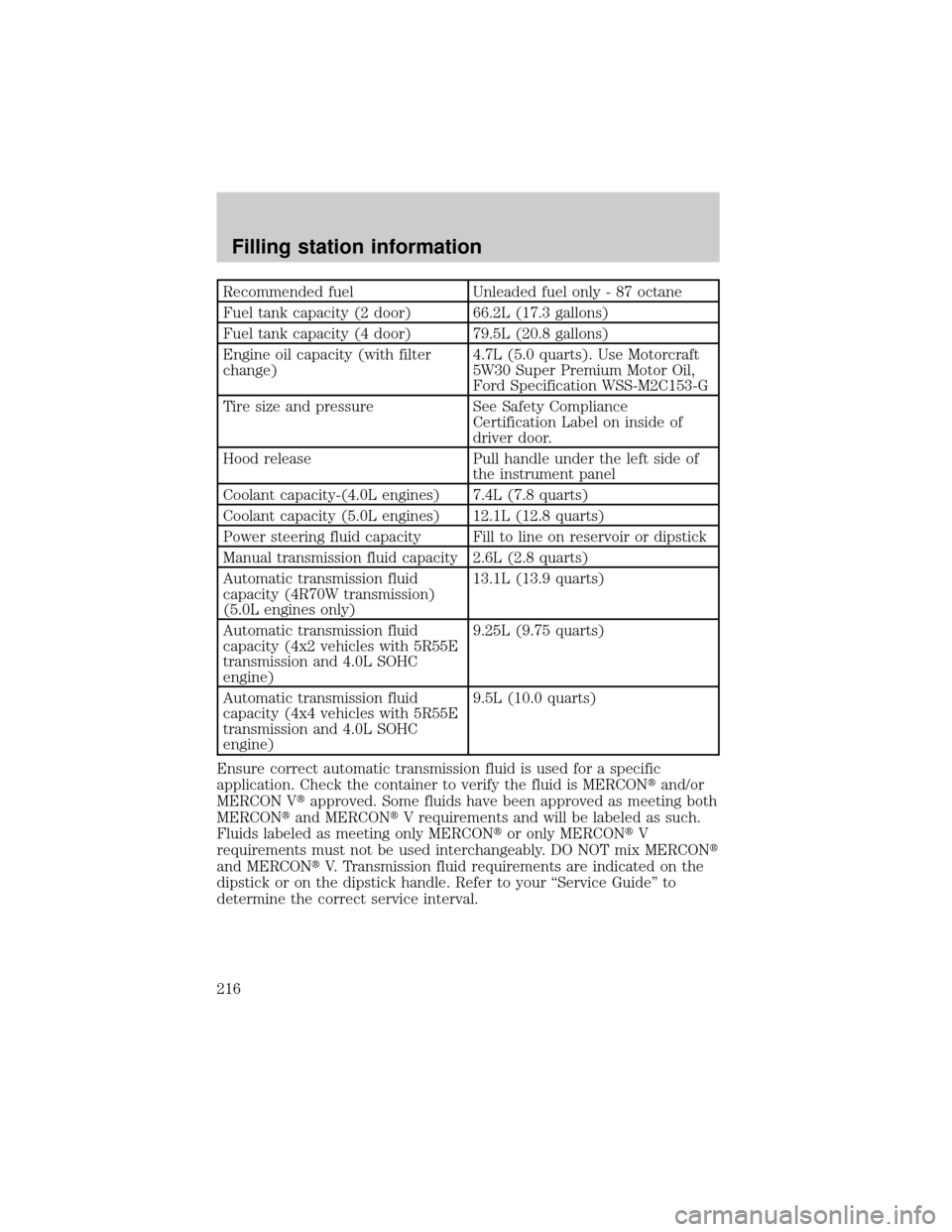
Recommended fuel Unleaded fuel only - 87 octane
Fuel tank capacity (2 door) 66.2L (17.3 gallons)
Fuel tank capacity (4 door) 79.5L (20.8 gallons)
Engine oil capacity (with filter
change)4.7L (5.0 quarts). Use Motorcraft
5W30 Super Premium Motor Oil,
Ford Specification WSS-M2C153-G
Tire size and pressure See Safety Compliance
Certification Label on inside of
driver door.
Hood release Pull handle under the left side of
the instrument panel
Coolant capacity-(4.0L engines) 7.4L (7.8 quarts)
Coolant capacity (5.0L engines) 12.1L (12.8 quarts)
Power steering fluid capacity Fill to line on reservoir or dipstick
Manual transmission fluid capacity 2.6L (2.8 quarts)
Automatic transmission fluid
capacity (4R70W transmission)
(5.0L engines only)13.1L (13.9 quarts)
Automatic transmission fluid
capacity (4x2 vehicles with 5R55E
transmission and 4.0L SOHC
engine)9.25L (9.75 quarts)
Automatic transmission fluid
capacity (4x4 vehicles with 5R55E
transmission and 4.0L SOHC
engine)9.5L (10.0 quarts)
Ensure correct automatic transmission fluid is used for a specific
application. Check the container to verify the fluid is MERCONtand/or
MERCON Vtapproved. Some fluids have been approved as meeting both
MERCONtand MERCONtV requirements and will be labeled as such.
Fluids labeled as meeting only MERCONtor only MERCONtV
requirements must not be used interchangeably. DO NOT mix MERCONt
and MERCONtV. Transmission fluid requirements are indicated on the
dipstick or on the dipstick handle. Refer to your ``Service Guide'' to
determine the correct service interval.
Filling station information
216